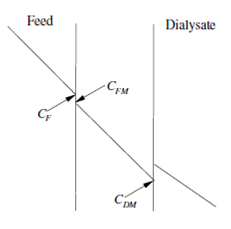Typical concentration profile in dialysis process:
Here is the most significant parameter to characterize dialysis procedure is the diffusive solute flux (JD) across the membrane that is given through
JD = K Dm ?C/ ?x
where Dm indicates solute diffusion coefficient in the membrane, ?C is the focus gradient of solute across the membrane and K is the partition coefficient described as the ratio of solute concentrations among membrane and external solutions on either side at equilibrium. Figure display a typical concentration profile for diffusive transport across a dialysis procedure.

Figure: Typical concentration profile in dialysis process
In this instance, the solute is less soluble in the membrane than in the external phases.
The partition coefficient K is given through
K = CFM / CF = CDM /CD
The product KDm /?x is frequent termed membrane diffusive permeability (Pm) of the solute. If two or more solutes are dialysing at the similar time, the degree of separation or enrichment is proportional to the ratio of their permeabilities. The closer the diffusive permeability of a solute in the membrane is to that in free solution, the more rapid will be the dialytic transport.
Pm = K DM/ ? x
and
JD = Pm ?C
The above equations also indicate that the diffusive solute flux in dialysis process is inversely proportional to the membrane thickness but the degree of separation among different solutes (selectivity) is independent of membrane thickness. For this purpose, dialysis membranes are always made as thin as probable consistent along with the requirement of mechanical strength and reliability.